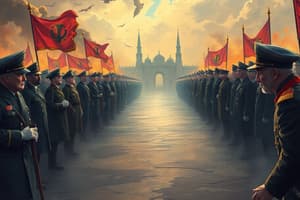Podcast
Questions and Answers
Which of the following was NOT a primary factor contributing to the outbreak of World War II?
Which of the following was NOT a primary factor contributing to the outbreak of World War II?
- The Treaty of Versailles, which imposed harsh terms on Germany after World War I.
- The widespread adoption of democratic principles across Europe. (correct)
- The failure of appeasement policies in addressing aggressive expansionist actions.
- The rise of dictatorships and totalitarian regimes in several countries.
How did Benito Mussolini demonstrate aggressive behavior prior to World War II?
How did Benito Mussolini demonstrate aggressive behavior prior to World War II?
- Through promoting cultural exchange programs with neighboring countries.
- By advocating for pacifism and disarmament at international conferences.
- By implementing economic reforms that fostered international cooperation.
- Through military expansion and territorial conquests in Africa. (correct)
What is the most accurate description of the policy of appeasement?
What is the most accurate description of the policy of appeasement?
- An economic policy of imposing sanctions to weaken potential adversaries.
- A diplomatic approach focused on compromise with an aggressive power to avoid conflict. (correct)
- A strategy of direct military confrontation to deter aggression.
- A policy of forming military alliances to collectively resist any aggressor.
The Munich Conference is most associated with what action?
The Munich Conference is most associated with what action?
Which countries appealed to others in an attempt to stop Hitler's expansionist policies?
Which countries appealed to others in an attempt to stop Hitler's expansionist policies?
What was the significance of the Rhineland in the lead-up to World War II?
What was the significance of the Rhineland in the lead-up to World War II?
How did Europe generally react to the Munich Conference?
How did Europe generally react to the Munich Conference?
Who specifically criticized the policy of appeasement?
Who specifically criticized the policy of appeasement?
What was the primary reason why Great Britain and France adopted a policy of appeasement toward Germany?
What was the primary reason why Great Britain and France adopted a policy of appeasement toward Germany?
What action directly followed the Munich Agreement and the annexation of Sudetenland?
What action directly followed the Munich Agreement and the annexation of Sudetenland?
What was the main purpose of the Nazi-Soviet Pact?
What was the main purpose of the Nazi-Soviet Pact?
What agreement was secretly outlined in the Nazi-Soviet Pact?
What agreement was secretly outlined in the Nazi-Soviet Pact?
Which countries declared war on Germany following the invasion of Poland?
Which countries declared war on Germany following the invasion of Poland?
What is the strategic purpose of 'Blitzkrieg'?
What is the strategic purpose of 'Blitzkrieg'?
How did Germany attempt to legitimize its invasion of Poland?
How did Germany attempt to legitimize its invasion of Poland?
Which phrase best describes the foreign policy of the United States after World War I?
Which phrase best describes the foreign policy of the United States after World War I?
What was the primary characteristic of the Neutrality Acts passed by the United States?
What was the primary characteristic of the Neutrality Acts passed by the United States?
What was the main principle of isolationism during the interwar period?
What was the main principle of isolationism during the interwar period?
What was the significance of the Lend-Lease Act of 1941?
What was the significance of the Lend-Lease Act of 1941?
Which countries formed the primary alliance known as the Axis Powers?
Which countries formed the primary alliance known as the Axis Powers?
Flashcards
What were the 6 main causes of World War II?
What were the 6 main causes of World War II?
Treaty of Versailles, Failure of Appeasement, Worldwide Depression, Imperialism, Rise of Dictators, Nationalism.
What is appeasement?
What is appeasement?
Compromising with an aggressive leader.
How did Western Countries appease Germany?
How did Western Countries appease Germany?
They allowed him to have Sudetenland if he didn't take any more territory (Munich Conference).
Who did many nations appeal to, to stop Hitler?
Who did many nations appeal to, to stop Hitler?
Signup and view all the flashcards
Area where Hitler violated the Treaty of Versailles?
Area where Hitler violated the Treaty of Versailles?
Signup and view all the flashcards
Area Germany received after the Munich Conference?
Area Germany received after the Munich Conference?
Signup and view all the flashcards
Who did Winston Churchill blame for the lack of action against Germany?
Who did Winston Churchill blame for the lack of action against Germany?
Signup and view all the flashcards
Why did countries choose appeasement?
Why did countries choose appeasement?
Signup and view all the flashcards
After Sudetenland, what was Hitler's next target?
After Sudetenland, what was Hitler's next target?
Signup and view all the flashcards
What was the Nazi-Soviet Pact?
What was the Nazi-Soviet Pact?
Signup and view all the flashcards
Secret Agreement in the Nazi-Soviet Pact?
Secret Agreement in the Nazi-Soviet Pact?
Signup and view all the flashcards
Who declared war on Germany after Poland's invasion?
Who declared war on Germany after Poland's invasion?
Signup and view all the flashcards
What is Blitzkrieg?
What is Blitzkrieg?
Signup and view all the flashcards
US foreign policy after WW1?
US foreign policy after WW1?
Signup and view all the flashcards
What were the Neutrality Acts?
What were the Neutrality Acts?
Signup and view all the flashcards
Isolationism vs. Interventionism?
Isolationism vs. Interventionism?
Signup and view all the flashcards
Axis Powers?
Axis Powers?
Signup and view all the flashcards
French fortification to defend against Germany?
French fortification to defend against Germany?
Signup and view all the flashcards
Location where British and French troops became trapped?
Location where British and French troops became trapped?
Signup and view all the flashcards
Turning point during Operation Barbarossa?
Turning point during Operation Barbarossa?
Signup and view all the flashcards
Study Notes
- Six main causes of World War II include the Treaty of Versailles, failure of appeasement, worldwide depression, imperialism, rise of dictators, and nationalism.
- Before World War II, Italy, Germany, and Japan were aggressor nations
- Italy was led by Benito Mussolini
- Germany was led by Adolf Hitler
- Japan was led by Hideki Tojo
- Appeasement means compromising with an aggressive leader.
- Western countries appeased Germany's demands by allowing Germany to have Sudetenland, based on the Munich Conference agreement that Germany would not take any more territory.
- Many nations appealed to France and Britain to stop Hitler.
- Hitler violated the Treaty of Versailles by sending troops to the Rhineland, the area between France and Germany.
- After the Munich Conference, Germany received the Sudetenland.
- After the Munich Conference, Europe's general mood was that they had achieved "peace" with Germany, so they celebrated.
- Winston Churchill blamed the British and French governments for the lack of action against Germany.
- Great Britain and France chose appeasement to avoid future war and economic disaster.
- After Sudetenland, Hitler's next target was Poland.
- The Nazi-Soviet Pact was an agreement between Germany and the Soviet Union in which they agreed not to attack each other.
- The secret agreement in the Nazi-Soviet Pact was the division of Poland between Germany and the Soviet Union.
- France and Britain declared war on Germany two days after Germany invaded Poland.
- Blitzkrieg is a war tactic involving columns, called panzer divisions (tanks), supported by planes, with the goal to win the war without fighting.
- Germany justified invading Poland by saying there were Germans in Poland with shared cultural similarities.
- After World War I, the United States foreign policy can best be described as isolationism.
- The Neutrality Acts involved the U.S. selling war products using the "cash and carry" method (buyers pay in advance and transport the goods themselves) to avoid involvement in the war.
- Isolationism is the belief that the U.S. should stay out of war, while interventionism supports the U.S. getting involved in the war.
- The Lend-Lease Act of 1941 involved the U.S. providing destroyer ships and other war equipment to enemies of the Axis powers, and revealing German submarines to the British.
- The Axis Powers were Germany, Italy, and Japan.
- After the Phony War ended, Germany attacked Denmark and Norway.
- The Maginot Line was the fortification France built to defend against Germany.
- The Nazis faced their first major defeat and were unable to invade Britain during the Blitz.
- British and French troops became trapped on the beaches of Dunkirk.
- The Battle of Stalingrad during Operation Barbarossa was considered a turning point in the war.
- Key European countries during World War II include Great Britain, France, the Soviet Union, Germany, Italy, and Poland.
Studying That Suits You
Use AI to generate personalized quizzes and flashcards to suit your learning preferences.





